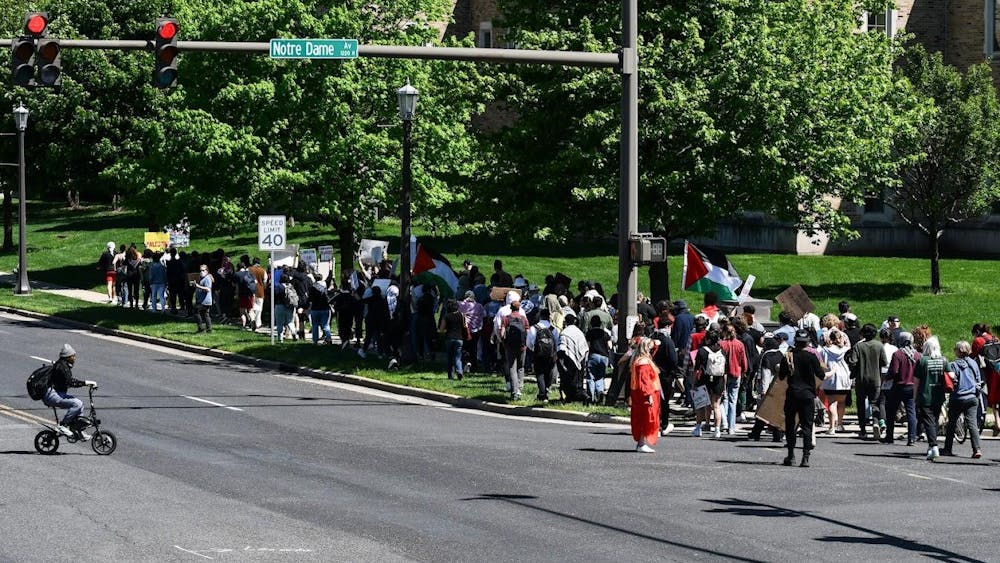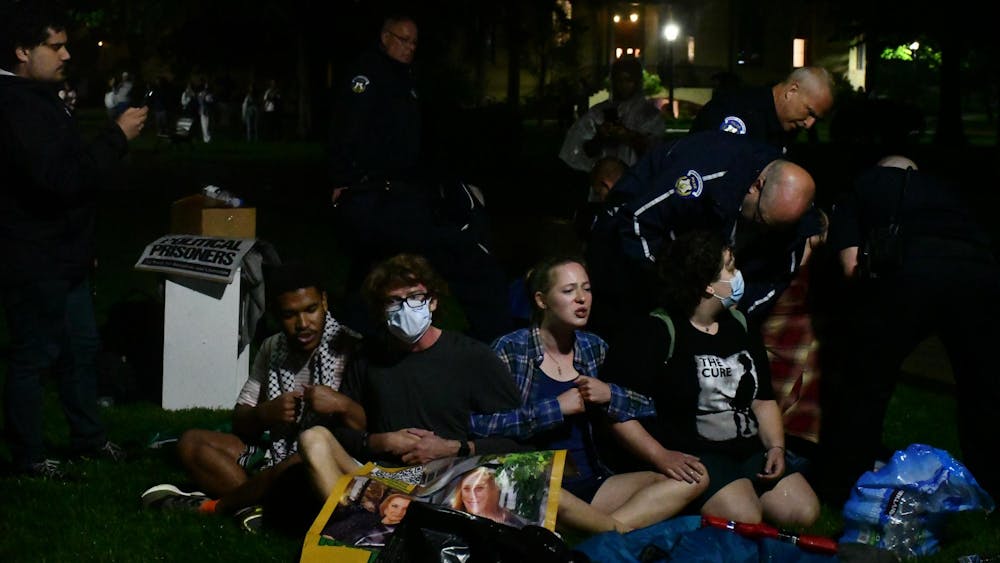In the beginning, the University of Notre Dame was a log chapel alongside a lake in northern Indiana. Following the chapel's construction, a church was built, and this same church became the Basilica of the Sacred Heart, which celebrates its 125th anniversary this year.

Sacred Heart Church, now the Basilica of the Sacred Heart, was consecrated on August 15, 1888. Fr. Peter Rocca, rector of the Basilica, said the building's exterior has not changed since that day in 1888, although it took four additional years to complete the spire and bell tower.
"Fr. Sorin was very progressive in terms of education theory, but he was very conservative in his tastes," Rocca said. "The bells in the tower were made in France, and all the stained glass windows came from France. In the Basilica, we have maybe the largest collection of 19th century French stained glass in one place."
The original Sacred Heart Church was 90 feet long by 38 feet wide, Rocca said. Because the original structure was torn down as the second one was constructed, he said the two represent a continuity of communities although the exterior building changed.
When the history is traced back to the 1847 origins, the current Basilica is the oldest church built in North America by the Congregation of Holy Cross, according to Rocca. Acknowledging its historical significance and lasting vitality, Pope John Paul II declared the church a basilica on Jan. 17, 1992.
"Basilica is an honorary title given to a church for a number of reasons," Rocca said. "First, it has to have great historical significance... and another reason would be because it's a place of pilgrimage. We usually have 100,000 people visit the Basilica each year.
Thirdly, usually a church that is designated a basilica is a living, vibrant community of faith, and our Basilica is a place where worship is celebrated regularly.

"Finally, a church that has been dedicated a basilica should be beautiful and well taken care of. It's no doubt that the Basilica of the Sacred Heart is one of the most beautiful churches around."
The designation as basilica followed a 14-month multi-million dollar renovation financed by former University trustee Thomas Coleman, Rocca said.
"[During this renovation], all the frescos were redone and all the stained glass windows were cleaned," he said. "The church received new lighting, air conditioning, carpeting and a whole new slate roof.
"It was especially important that those paintings be restored because many of them had been covered with dust and dirt and incense smoke and had become dull. They were redone using the same method used in the Sistine Chapel to restore Michaelangelo's frescoes."
Rocca said the completion of the spire with the bell tower in 1892 represented the fulfillment of one of Fr. Sorin's dreams.
"One of the reasons Fr. Sorin wanted a nice bell tower was because he had been buying all these bells in the 1850s. He loved bells," Rocca said. "These bells were made in France, and the first Sacred Heart Church had two wooden towers that could not support bells.
"For the longest time, he was collecting these bells from France, and he built a giant black crate in front of the Main Building to hold the bells until he could build a proper tower for them."
The bells currently housed in the spire of the Basilica are the same ones acquired by Sorin, Rocca said.
"There are 23 bells up there plus one additional bell that weighs eight tons," he said. "The 23 form what is called a carillon, which means the bells can play carols or tunes. We believe that this is the oldest carillon in North America."
Rocca said the Basilica of the Sacred Heart is not synonymous with Sacred Heart Parish, which is housed in the crypt of the building and is a "totally separate operation" with its own pastor and programming. The only person buried in the basilica proper is former University president John Francis Cardinal O'Hara, who led Notre Dame before World War II, he said. O'Hara served in the military archdiocese and went on to be the bishop of Buffalo, New York, and archbishop of Philadelphia, Penn.
"The story goes that the people of Philadelphia loved Cardinal O'Hara and... they wanted him to be buried in the crypt of the cathedral in Philadelphia," Rocca said. "But Cardinal O'Hara wanted to be buried with his fellow Holy Cross priests and brothers in our Holy Cross cemetery here.
"Apparently, after he died they realized there was a Church law that forbade cardinals from being buried underground, so he could not be buried in the community cemetery. Instead, they buried him in the then-Sacred Heart Church."
Though the true 125th anniversary occurred on August 15, Rocca said a celebration was held on August 16th to commemorate the original consecration while still observing the Feast of the Assumption of the Virgin Mary on the 15th. A "pick-up choir" made up of mostly past and current members of Notre Dame's liturgical choir sang for the Mass celebrated by Holy Cross Bishop Daniel Jenky of the diocese of Peoria, Ill., he said.
"Following the Mass, there was a grand reception for everyone in the rotunda of the Main Building," Rocca said. "Following the reception, there was a dinner for about 90 invited guests on the 14th floor of the Hesburgh Library, which was the perfect location because it has an incredible view of the side of the Basilica, the same view it would have been so long ago."
Contact Ann Marie Jakubowski at ajakubo1@nd.edu












